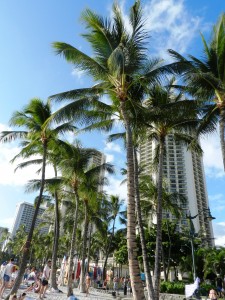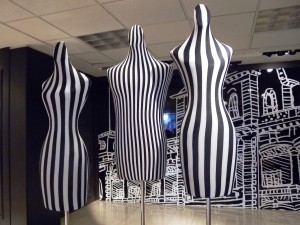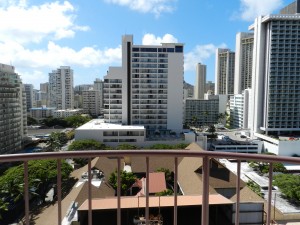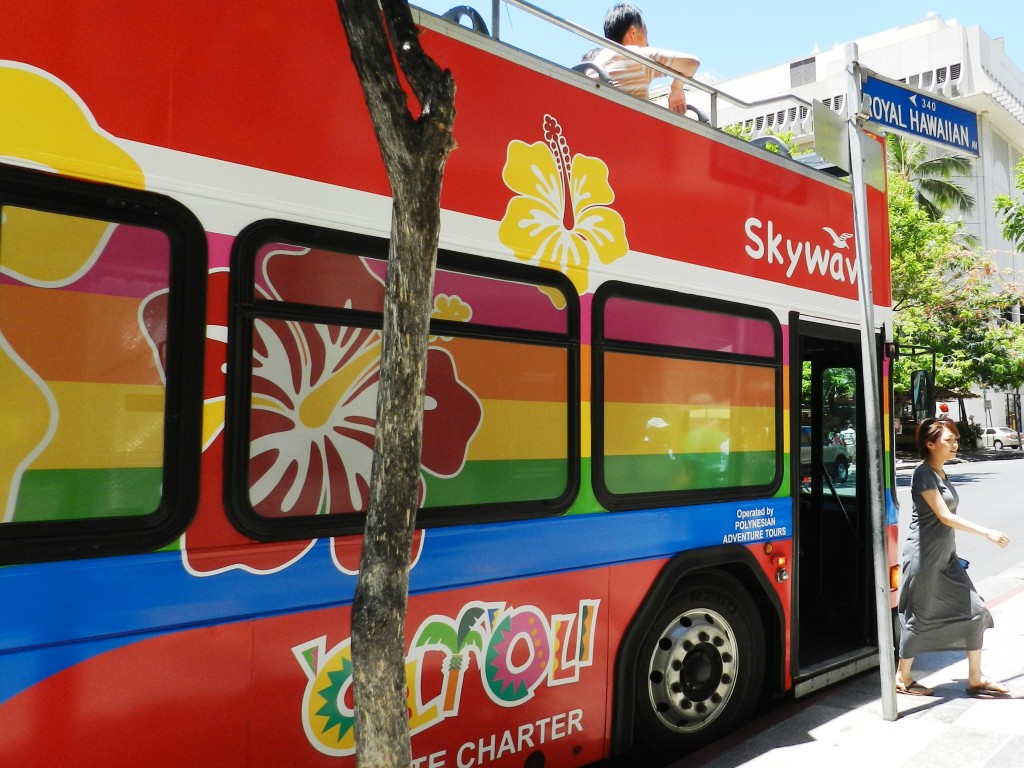» posted on Wednesday, June 27th, 2012 by Linda Lou Burton
A Loverly Bunch of Coconuts
 Linda Burton posting from Honolulu, Hawaii – “Thank you, thank you, thank you,” they muttered as we applauded the procession coming towards us on the sidewalk. Ten blond California-stereo guys in grass skirts and coconut bras were catching the attention they sought on the streets of Waikiki, turning heads and generating laughter along the way. A pirate look-alike with a bright green parrot on his shoulder hung out mid-block offering opportunity – Pose with Polly, $10. Just in front of our hotel, a black man in baggy white shorts was turning circles to the count of two passers-by; when he got to 13 they yelled “Jump!” and he did a backflip, barefoot, without falling down. And then collected his tip. Not weird, in this party town, where the sheltering palms seem to attract an odd assortment of coconuts.
Linda Burton posting from Honolulu, Hawaii – “Thank you, thank you, thank you,” they muttered as we applauded the procession coming towards us on the sidewalk. Ten blond California-stereo guys in grass skirts and coconut bras were catching the attention they sought on the streets of Waikiki, turning heads and generating laughter along the way. A pirate look-alike with a bright green parrot on his shoulder hung out mid-block offering opportunity – Pose with Polly, $10. Just in front of our hotel, a black man in baggy white shorts was turning circles to the count of two passers-by; when he got to 13 they yelled “Jump!” and he did a backflip, barefoot, without falling down. And then collected his tip. Not weird, in this party town, where the sheltering palms seem to attract an odd assortment of coconuts.
Waikiki Beach isn’t where the natives live, it’s filled with Mainlanders and Japanese and Aussies; with tourists and shoppers and surfer wannabes. The Japanese come for shopping, I’m told, as high-end items cost a fraction of what they’d cost in Japan.  The Aussies come for a good-time, mate, the 10-hour flight is about as close a vacation spot as any other, once you leave the continent. The Mainlanders come because, well, Hawaii is the warmest point of exotica you can get to without a passport. And tourism is the #1 revenue source; visitors emptied their pockets to the tune of $11.2 billion in 2010. So how do the locals feel about that?
The Aussies come for a good-time, mate, the 10-hour flight is about as close a vacation spot as any other, once you leave the continent. The Mainlanders come because, well, Hawaii is the warmest point of exotica you can get to without a passport. And tourism is the #1 revenue source; visitors emptied their pockets to the tune of $11.2 billion in 2010. So how do the locals feel about that?
“I hate the way Waikiki Beach is today,” Sylvia told us, as we rested on a bench at the Aquarium. Sylvia is a docent there, volunteering time each week. She pointed to the now-decaying natatorium on the beach. “I used to swim there, way back. It was built for the Olympic Games, and has such a famous history, but they say restoring it today would be impossible, it’s too far gone.” Sylvia recalled the time when Waikiki was the site of only a few lovely hotels, living costs were reasonable, and everything had a friendly neighborhood feel. “My neighborhood is still fairly quiet,” she said, “but I won’t drive into Waikiki Beach, it’s just too congested.” I heard that remark from Lara in the bank on Kuhio Street, she drives in to work every day, but complained about the length of her commute “We now claim the “most congested” traffic anywhere in the US,” she said, shaking her head. 
The wackiness seems to be mostly confined to Waikiki; someone who works downtown told me she would never venture there. But, on the other hand, Waikiki Beach is practically a synonym for “jobs”; the unemployment rate for this area is under 6%. I’ve tried to get a handle on the number of hotels in this relatively small area; one source claims there are 74, with over 30,000 rooms, but I have not verified that statistic. Looking out the window of my own hotel, I would guess the number is higher than that. Now, consider the support systems that many hotels would require; besides maintaining the hotels, you need restaurants to feed the visitors, shopping and entertainment venues, and transportation to move everyone around (no one drove here for a visit!). That’s a lot of employment opportunities.
 I was overwhelmed by the variety of things to do and places to go that vied for my attention. The transportation options alone were astounding: “The Bus” is the standard city bus although double-decker touring buses abound; “The Cab” seemed to be the most reliable taxi although there are many independents. The Waikiki Trolley runs three routes promoted as “tours” – Red for historic; Green for sightseeing; and the every-ten-minutes Pink Line that takes you directly to Ala Moana Shopping Mall. Speedi-Shuttle gets you to the airport; stretch white limos are more prolific than taxis; and charter tour buses routinely edge out passenger cars, after all, they’ve got 50 people on board eager to “get somewhere” within their allotted vacation time.
I was overwhelmed by the variety of things to do and places to go that vied for my attention. The transportation options alone were astounding: “The Bus” is the standard city bus although double-decker touring buses abound; “The Cab” seemed to be the most reliable taxi although there are many independents. The Waikiki Trolley runs three routes promoted as “tours” – Red for historic; Green for sightseeing; and the every-ten-minutes Pink Line that takes you directly to Ala Moana Shopping Mall. Speedi-Shuttle gets you to the airport; stretch white limos are more prolific than taxis; and charter tour buses routinely edge out passenger cars, after all, they’ve got 50 people on board eager to “get somewhere” within their allotted vacation time.
My informal poll asking “why do you live here?” turned up the same response from every single resident I questioned – tour bus and taxi drivers, restaurant workers, hotel employees, office workers, retirees; native born or from Viet Nam or New Jersey. Despite the congestion, and noise, and never-ending parade of “coconuts” that make up their daily routine, the answer was simple “I may travel all over the world, but I wouldn’t think of living anywhere else.” 
